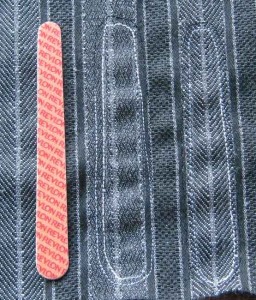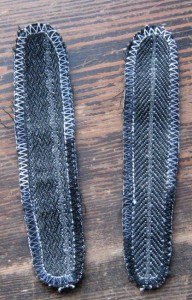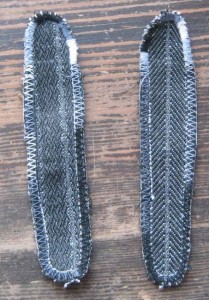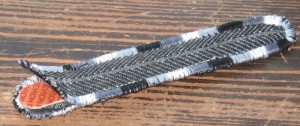Scratch protection
Mein derzeitiger Trieb, den Stoff möglichst “Auzuarbeiten”, statt die Reste zu lagern führt dazu, daß ich auch Sachen mache, die ich schon immer mal machen wollte, die aber einfach nie gemacht wurden. Ich habe extrem brüchige Nägel, die Kanten die dann übrig bleiben sind aber sehr scharf, so daß man sich damit erstaunlich tiefe Kratzer zufügen kann. Also habe ich immer eine Nagelfeile dabei.
I am eagerly working to use up all that fabric from the skirt project and the result is, that some ideas I had been wanting to make for long but somehow never happened get finally executed. My fingernails break very easily and the resulting edge can be quite sharp. It is surprising how deep scratches you can execute to yourself with that… So I always carry an emery board with me.
Nur… so eine Nagelfeile feilt nicht nur Nägel, sondern sie kratzt auf allem herum. Kameradisplays zum Beispiel. Und was noch so in meiner Handtasche rumfliegt. Dabei kostet es wirklich nur wenig Zeit und kaum Material, so eine Hülle zu nähen.
Only this does not only smooth nails, it scratches anything. Like displays of cameras. And anything else in my handbag. And it costs hardly any tome and even less material to make a cover.
 Man braucht einen Rest eines etwas festern Stoffs (so wie mitteldicker Jeans zum Beispiel), auf dem zeichnet man zuerst die Umrisse der Feile nach und umnäht die dann zweimal. Einmal auf der gezeichneten Linie, einmal ca 3mm daneben. Kurze Stiche, Stichlänge 2.
Man braucht einen Rest eines etwas festern Stoffs (so wie mitteldicker Jeans zum Beispiel), auf dem zeichnet man zuerst die Umrisse der Feile nach und umnäht die dann zweimal. Einmal auf der gezeichneten Linie, einmal ca 3mm daneben. Kurze Stiche, Stichlänge 2.
You need a scrap of firm fabric like decorators fabric or denim, then you trace the outlines of your emery board. With a short stitch (lenght 2mm) of your sewing machine you stitch once on that line and a second time about 3mm on the outside of it.
 Danach die Maschine auf Zickzack stellen, Breite 4,5 mm, Stichlänge 1,5mm und wieder die Form umrunden. Dabei trifft der “innere” Stich des Zickzacks die innere Stepplinie. Danach knapp an den Stichen entlang ausschneiden.
Danach die Maschine auf Zickzack stellen, Breite 4,5 mm, Stichlänge 1,5mm und wieder die Form umrunden. Dabei trifft der “innere” Stich des Zickzacks die innere Stepplinie. Danach knapp an den Stichen entlang ausschneiden.
Then you set your machine to zigzag stitch, width 4.5mm, length 1.5mm and you sew around your stitching line. The “inner” stitch of the zigzag hits your inner line of straight stitch. Then cut away the fabric close to the stitching.
Ich habe ein Farbverlaufsgarn von Valdani genommen (“Monochrome M-31”), aber normales Nähgarn geht natürlich auch.
I’ve used variegated thread from Valdani (“Monochrome M-31”), but normal sewing or embroidery thread does the same.
 Jetzt den Stich breiter (5mm) und kürzer stellen (so wie sonst bei der Knopflochraupe oder zum applizieren) und am breiteren Ende die Rundung umnähen. Etwa 2,5cm unterhalb anfangen und genauso weit auf der anderen Seite runter nähen.
Jetzt den Stich breiter (5mm) und kürzer stellen (so wie sonst bei der Knopflochraupe oder zum applizieren) und am breiteren Ende die Rundung umnähen. Etwa 2,5cm unterhalb anfangen und genauso weit auf der anderen Seite runter nähen.
Now set your machine to a wider (5mm) and shorter zigzag stitch. Same stitchlength as you would use for a buttonhole or for appliqué. Now you sew around the curve of the wider end of your fabric strip. Start about 2,5cm down from the “peak”, sew over the curve and go down on the other side the same length.
Zuletzt die beiden Stoffstreifen links auf links aufeinander legen (falls es eine linke Seite gibt) und den Rest mit der engen Zickzack Raupe umrunden. Also Zusammennähen und Versäubern in einem.
 Now lay both pieces on each other, left sides facing (if there is a left side) and sew around the rest with the same buttonhole zigzag stitch as before. That sews the pieces together and overcasts in one step.
Now lay both pieces on each other, left sides facing (if there is a left side) and sew around the rest with the same buttonhole zigzag stitch as before. That sews the pieces together and overcasts in one step.
Nagelfeile rein, das war es auch schon. Keine Kratzer mehr. 🙂
That’s all, put your emery board in. No more damage in the hand bag. 🙂
